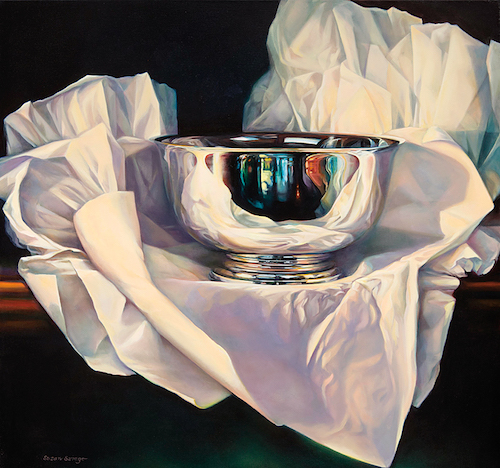Westmont Magazine More Than Meets the Eye
An edited excerpt of a talk by Susan Savage, professor of Art

“Received,” 34 x 22 inches, 2013, Oil on canvas by Susan Savage, Professor of Art, 1992-2014
A liberal arts education is a process of interdisciplinary integration. It’s a community that works together to celebrate and nurture relationships of knowledge, inviting a variety of approaches to such integration.
In its goal to educate the whole person, such education focuses on the well-rounded cultivation of the mind, encouraging intellectual curiosity, open-mindedness and enhanced creativity. It enables students to learn how to learn as they mature academically and move into the next phases of their lives.
The intellect is concerned with creating and discovering meaning, finding significance in things and events. The arts support and contribute mightily to this process. Striving to make sense of things, the intellect finds a rational form, a unified order and an inner coherence. The student artist has much to gain from such a focus—and much to contribute to it.
Even though the work of artists is primarily known as a physical product, they invest a great deal of time, effort and intellectual struggle in a final formulation. This engagement requires asking questions, solving problems, taking risks, and making and remaking decisions.
Struggle is a key ingredient, and it lies at the heart of success. Often failures and experimentation teach us a great deal more than successes, for the seeds of the next idea lie in the revelations that failure produces. Struggle teaches endurance, strengthens the individual and nurtures confidence.
Training in visual perception contributes to a heightened awareness of what is around us, especially things that might seem insignificant. This sharpens the artist’s perceptions so that seeing becomes knowing and they can more imaginatively give away what they’ve learned.
A sustained endeavor that draws on the whole being, the making of art is a consequence of disciplined effort, not merely a recreational activity. As human beings created in God’s image, we bear the mark of His creativity as well as His impulse in us to create. God, as our creator, created us to be creators. We therefore can’t think of art-making as something superfluous. Our works are new creations, not a redoing of what God did. We aren’t mirrors of His image; we are bearers. We create as He created. We do as He has done.
By embracing the nebulous realm of creativity and invention, with its grey areas and experimentation, the art program in the Christian liberal arts experience encourages students to develop their identity as creative beings. It prepares them to use their God-given abilities to make significant and interesting contributions to the growing complexities of our world.
One of our most significant gifts is imagination, the ability to look beyond what is immediately present to what might be. Our imagination helps us order our world and make sense of our experiences. It puts us in touch with a larger narrative so we see differently and think more clearly about the world and our place in it. Artists are curious people who pick up on those connections. They explore quirky things that many might overlook or never consider. The things artists create cultivate meaning, bring things to our attention, and make us reconsider ourselves.
Students who study art in the Christian liberal arts tradition receive training in original thinking and expressive responses that lead them to form critical judgments, informed opinions and consequent actions. God doesn’t call us just to express ourselves but to give meaning to the world that He has created for us. He calls us to nurture the world and govern it, to share our voices as Christians and artists.
It’s vital that we continue to nurture artists of vision and assist those able to authentically incarnate the experiences of mystery, wonder and awe so prevalent in the Christian realm. We can’t afford to ignore the study of art in Christian higher education or pass by a work of art as it hangs on a wall or stands before us. Otherwise, we cut ourselves off from an important means of perceiving life’s ultimate meanings.
Art points beyond itself to something the artist hopes will warrant the attention and understanding of others. It seeks transcendence as it connects with viewers. Artists invite viewers to stand where they once stood.
Neuroscience has shown that the strategies employed in art lend themselves to memory. In the right context, a work of art will connect with a memory, stay with us and make meaning for us—if we spend the time to look deeply at the work and hear it speak.
There is more to art than meets the eye. Opening our eyes to the unseen, embracing the mystery of what we see, is up to the receiver. Artists are just the messengers.